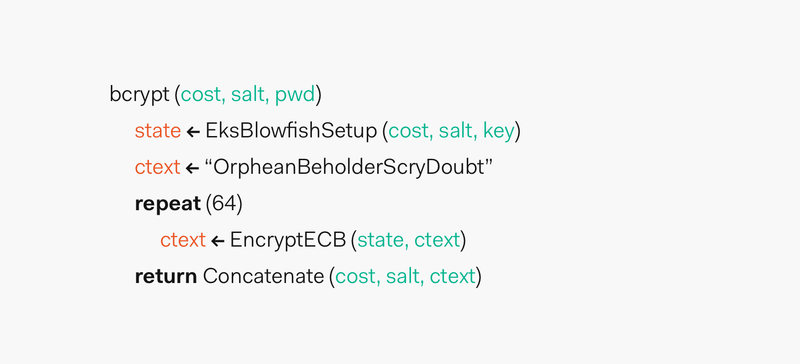In previous posts to this Authentication Saga, we learned that storing passwords in plaintext must never be an option. Instead, we want to provide a one-way road to security by hashing passwords. However, we also explored that hashing alone is not sufficient to mitigate more involved attacks such as rainbow tables. A better way to store passwords is to add a salt to the hashing process: adding additional random data to the input of a hashing function that makes each password hash unique. The ideal authentication platform would integrate these two processes, hashing and salting, seamlessly.
There are plenty of cryptographic functions to choose from such as the
family and the SHA2
family. However, one design problem with the SHA-3
SHAFaster calculations mean faster brute-force attacks, for example. Modern hardware in the form of CPUs and GPUs could compute millions, or even billions, of SHA-256 hashes per second against a stolen database. Instead of a fast function, we need a function that is slow at hashing passwords to bring attackers almost to a halt. We also want this function to be adaptive so that we can compensate for future faster hardware by being able to make the function run slower and slower over time.
At Auth0, the integrity and security of our data are one of our highest priorities. We use the industry-grade and battle-tested
bcryptbcryptbcryptMotivation Behind 'bcrypt'
Technology changes fast. Increasing the speed and power of computers can benefit both the engineers trying to build software systems and the attackers trying to exploit them. Some cryptographic software is not designed to scale with computing power. As explained earlier, the safety of the password depends on how fast the selected cryptographic hashing function can calculate the password hash. A fast function would execute faster when running in much more powerful hardware.
To mitigate this attack vector, we could create a cryptographic hash function that can be tuned to run slower in newly available hardware; that is, the function scales with computing power. This is particularly important since, through this attack vector, people tend to keep the length of the passwords constant. Hence, in the design of a cryptographic solution for this problem, we must account for rapidly evolving hardware and constant password length.
This attack vector was well understood by cryptographers in the 90s and an algorithm by the name of
bcryptbcryptWhat is `'bcrypt'?
bcryptbcryptcryptcryptcryptInherently, an attacker could then carry out a complete dictionary attack with extreme efficiency. Thus, cryptography that was exponentially more difficult to break as hardware became faster was required in order to hinder the speed benefits that attackers could get from hardware.
The Blowfish cipher is a fast block cipher except when changing keys, the parameters that establish the functional output of a cryptographic algorithm: each new key requires the pre-processing equivalent to encrypting about 4 kilobytes of text, which is considered very slow compared to other block ciphers. This slow key changing is beneficial to password hashing methods such as
bcryptAs shown in "Blowfish in practice",
bcryptbcryptbcryptbcrypt“`bcrypt` was designed for password hashing hence it is a slow algorithm. This is good for password hashing as it reduces the number of passwords by second an attacker could hash when crafting a dictionary attack. ”
Tweet This
Another benefit of
bcrypt“`bcrypt` forces you to follow security best practices as it requires a salt as part of the hashing process. Hashing combined with salts protects you against rainbow table attacks! Are password salts part of your security strategy?”
Tweet This
How does 'bcrypt' work?
Provos and Mazières, the designers of
bcryptWhat's "key setup"? According to Ian Howson, a software engineer at NVIDIA: "Most ciphers consist of a key setup phase and an operation phase. During key setup, the internal state is initialised. During operation, input ciphertext or plaintext is encrypted or decrypted. Key setup only needs to be conducted once for each key that is used"
runs in two phases:bcrypt
Phase 1:
A function called
EksBlowfishSetupeksblowfishbcryptWhat we are going through this first phase is to promote key strengthening to slow down calculations which in turn also slow down attackers.
Phase 2:
The magic value is the 192-bit value
OrpheanBeholderScryDoubteksblowfishThe resulting hash is prefixed with
$2a$$2y$$2b$bcryptThe result of
bcrypt- It's preimage resistant.
- The salt space is large enough to mitigate precomputation attacks, such as rainbow tables.
- It has an adaptable cost.
The designers of
bcryptRegarding adaptable cost, we could say that
bcrypt'bcrypt' Best Practices
The challenge of security engineers is to decide what cost to set for the function. This cost is also known as the work factor. OWASP recommends as a common rule of thumb for work factor setting to tune the cost so that the function runs as slow as possible without affecting the users' experience and without increasing the need to use additional hardware that may be over budget.
Let's take a closer look at an example based on OWASP recommendations:
- Perform UX research to find what are acceptable user wait times for registration and authentication.
- If the accepted wait time is 1 second, tune the cost of
for it to run in 1 second on your hardware.bcrypt - Analyze with your security team if the computation time is enough to mitigate and slow down attacks.
Users may be fine waiting for 1 or 2 seconds as they don't have to consistently authenticate. The process could still be perceived as quick. Whereas, this delay would frustrate the efforts of an attacker to quickly compute a rainbow table.
Being able to tune the cost of
bcryptCheck out a cool graph that shows the numbers of transistors on integrated circuit chips from 1971 to 2016.
“When using bcrypt, it's critical to find the right balance between security and usability. Increasing the cost factor increases computation time. Where do password operations happen? How long are your users willing to wait?”
Tweet This
As an example on how the increasing the work factor increases the work time, I created a Node.js script that computed the hash of
DFGh5546*%^__90const bcrypt = require("bcrypt"); const plainTextPassword1 = "DFGh5546*%^__90"; for (let saltRounds = 10; saltRounds < 21; saltRounds++) { console.time(`bcrypt | cost: ${saltRounds}, time to hash`); bcrypt.hashSync(plainTextPassword1, saltRounds); console.timeEnd(`bcrypt | cost: ${saltRounds}, time to hash`); }
In the next section, we are going to explore the Node.js implementation in more detail. The script was run on a 2017 MacBook Pro with the following specs (We get nice equipment at Auth0! Join us!):
- Processor: 2.8 GHz Intel Core i7
- Memory: 16 GB 2133 MHz LPDDR3
- Graphics: Radeon Pro 555 2048 MB, Intel HD Graphics 630 1536 MB
These are the results:
bcrypt | cost: 10, time to hash: 65.683ms bcrypt | cost: 11, time to hash: 129.227ms bcrypt | cost: 12, time to hash: 254.624ms bcrypt | cost: 13, time to hash: 511.969ms bcrypt | cost: 14, time to hash: 1015.073ms bcrypt | cost: 15, time to hash: 2043.034ms bcrypt | cost: 16, time to hash: 4088.721ms bcrypt | cost: 17, time to hash: 8162.788ms bcrypt | cost: 18, time to hash: 16315.459ms bcrypt | cost: 19, time to hash: 32682.622ms bcrypt | cost: 20, time to hash: 66779.182ms
Plotting this data in Wolfram Alpha to create a least-squares fit graph, we observe that the time to hash a password grows exponentially as the cost is increased in this particular hardware configuration:
For this data set, Wolfram Alpha gives us the following least-squares best fit equation:
28.3722 e^(0.705681x)
If we wanted to predict how long would it take to hash a password in this system when the cost is
30x28.3722 e^(0.705681(30)) = 44370461014.7
A cost factor of
3044370461014.7739507.68513.55bcryptIf a company ever detects or suspects that a data breach has compromised passwords, even in hash form, it must prompt its users to change their password right away. While hashing and salting prevent a brute-force attack of billions of attempts to be successful, a single password crack is computationally feasible. An attacker may, with tremendous amount of computational power, or by sheer luck, crack a single password, but even then, the process would be most certainly slow due to the characteristics of
bcryptNow that we understand how
bcryptImplementing 'bcrypt'
We are going to explore its implementation using Node.js and its popular node.bcrypt.js implementation. You don't need to create a Node.js project. The purpose of this section is to show the common steps that developers have to take when integrating
bcryptnode.bcrypt.jsnpmnpm install bcrypt
Then, on an entry-point file for the server, such as
app.js// app.js const bcrypt = require("bcrypt"); const saltRounds = 10; const plainTextPassword1 = "DFGh5546*%^__90";
bcryptsaltRoundsplainTextPassword1This Node.js implementation is interesting because it gives us two different techniques to hash the passwords. Let's explore them.
Technique 1: Generate a salt and hash on separate function calls.
// app.js const bcrypt = require("bcrypt"); const saltRounds = 10; const plainTextPassword1 = "DFGh5546*%^__90"; bcrypt .genSalt(saltRounds) .then(salt => { console.log(`Salt: ${salt}`); return bcrypt.hash(plainTextPassword1, salt); }) .then(hash => { console.log(`Hash: ${hash}`); // Store hash in your password DB. }) .catch(err => console.error(err.message));
Using the Promise pattern to control the asynchronous nature of JavaScript, in this technique, we first create a salt through the
bcrypt.genSaltsaltRoundssaltbcrypt.hashplainTextPassword1bcrypt.hashNotice that I included some
console.logsalthashsaltIn the first run, I got the following results in the command line:
Salt: $2b$10$//DXiVVE59p7G5k/4Klx/e Hash: $2b$10$//DXiVVE59p7G5k/4Klx/ezF7BI42QZKmoOD0NDvUuqxRE5bFFBLy
You won't be able to reproduce these results again since the salt is completely random every time
genSaltSalt: $2b$10$3euPcmQFCiblsZeEu5s7p. Hash: $2b$10$3euPcmQFCiblsZeEu5s7p.9OVHgeHWFDk9nhMqZ0m/3pd/lhwZgES
Hence, each password that we hash is going to have a unique salt and a unique hash. As we learned before, this helps us mitigate greatly rainbow table attacks.
Technique 2: Auto-generate a salt and a hash
In this version, we use a single function to both create the salt and hash the password:
// app.js const bcrypt = require("bcrypt"); const saltRounds = 10; const plainTextPassword1 = "DFGh5546*%^__90"; bcrypt .hash(plainTextPassword1, saltRounds) .then(hash => { console.log(`Hash: ${hash}`); // Store hash in your password DB. }) .catch(err => console.error(err.message));
This technique has a smaller footprint and may be easier to test. Again, a new hash is created each time the function is run, regardless of the password being the same.
Notice how in both techniques we are storing the hash and not the password. The user's password itself should not be stored anywhere in plaintext.
Once we have our password hashes stored in the database, how do we validate a user login? Let's check that out.
Validating a Password with a Hash
Using the
bcrypt.hash$2b$10$69SrwAoAUNC5F.gtLEvrNON6VQ5EX89vNqLEqU655Oy9PeT/HRM/a
Next, we are going to check the passwords and see how they match. First, we check if our stored hash matches the hash of the provided password:
// app.js const bcrypt = require("bcrypt"); const plainTextPassword1 = "DFGh5546*%^__90"; const hash = "$2b$10$69SrwAoAUNC5F.gtLEvrNON6VQ5EX89vNqLEqU655Oy9PeT/HRM/a"; bcrypt .compare(plainTextPassword1, hash) .then(res => { console.log(res); }) .catch(err => console.error(err.message));
In this case,
restrueOpposite, we expect to get
falseresplainTextPassword2// app.js const bcrypt = require("bcrypt"); const plainTextPassword1 = "DFGh5546*%^__90"; const plainTextPassword2 = "456kin&*jhjUHJ1"; const hash = "$2b$10$69SrwAoAUNC5F.gtLEvrNON6VQ5EX89vNqLEqU655Oy9PeT/HRM/a"; bcrypt .compare(plainTextPassword2, hash) .then(res => { console.log(res); }) .catch(err => console.error(err.message));
And, effectively,
resbcrypt.compareSalt: $2b$10$3euPcmQFCiblsZeEu5s7p. Hash: $2b$10$3euPcmQFCiblsZeEu5s7p.9OVHgeHWFDk9nhMqZ0m/3pd/lhwZgES
bcrypt.compareThat's the flow of using
bcryptOther languages would follow a similar workflow:
Here's an example using Spring Security for Java.
This example uses Django for Python.
Finally, this example uses Laravel for PHP.
Simplifying Password Management with Auth0
The main idea of password verification is to compare two hashes and determine if they match each other. The process is very complex. A solid identity strategy demands an organization to keep current with cryptographic advances, design a process to phase out deprecated or vulnerable algorithms, provide pen testing, invest in physical and network security among many others. With all factors considered, it isn't easy or inexpensive.
You can minimize the overhead of hashing, salting and password management through Auth0. We solve the most complex identity use cases with an extensible and easy to integrate platform that secures billions of logins every month.
Auth0 helps you prevent critical identity data from falling into the wrong hands. We never store passwords in cleartext. Passwords are always hashed and salted using bcrypt. We've built state-of-the-art security into our product, to protect your business and your users.
Make the internet safer, sign up for a free Auth0 account today.
About the author

Dan Arias
Staff Developer Advocate
The majority of my engineering work revolves around AWS, React, and Node, but my research and content development involves a wide range of topics such as Golang, performance, and cryptography. Additionally, I am one of the core maintainers of this blog. Running a blog at scale with over 600,000 unique visitors per month is quite challenging!
I was an Auth0 customer before I became an employee, and I've always loved how much easier it is to implement authentication with Auth0. Curious to try it out? Sign up for a free account ⚡️.View profile


